About Toyo University Enryo Inoue, "a giant of wisdom and action" who learned from the world
Enryo Inoue, "a giant of wisdom and action" who learned from the world and practiced common education in the early Meiji period
134 years ago, in 1887. After tireless efforts, Enryo Inoue founded the Tetsugakukan (“Academy of Philosophy”in English) at the young age of 29, two years after graduating from university. The Tetsugakukan was the predecessor organization of Toyo University, and it is from here that the story that connects us today began.
Enryo was born in a temple, and in the midst of the Meiji Restoration, he studied Chinese classics from the age of 10 and Western learning from the age of 16. At 23, he studied philosophy at the newly founded University of Tokyo.
It was here that Enryo became convinced that all knowledge is grounded in philosophy, regardless of whether it originated in the east or the west. This became the spirit that Toyo University is founded on, “The Basis of All Learning Lies in Philosophy.” Along with his educational activities at the Tetsugakukan, Enryo vigorously engaged in activities to spread philosophy. For example, in the Meiji period, when it was to go abroad, Enryo traveled around the world three times. He is also a forefather of social education, spreading the knowledge of what he learned from his travels all over Japan. Enryo is also known as the “Yōkai-hakase (Mistery Doc)” who researched yōkai (Mistery) in order to dispel superstitions.
When Enryo was your age, what was he thinking? What was he doing? If you think about him in this way, Enryo Inoue is sure to instantly become familiar to you. Please use this opportunity to learn about Enryo Inoue.
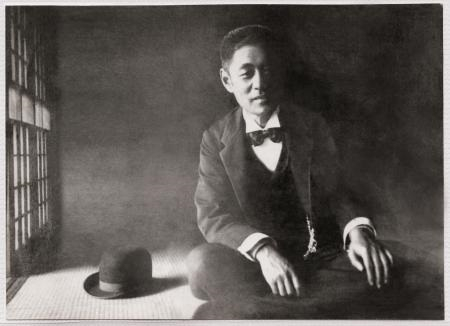
TOPIC
At Toyo University, we integrated the on-campus organizations on Enryo, and in 2021 established the “Inoue Enryo Center for Philosophy” to carefully preserve Enryo Inoue’s thoughts and passion from now into the future. We are also enhancing the preservation and research of accumulated materials along with the dissemination of information to society. As part of these initiatives, we plan to expand the facilities of Inoue Enryo Memorial Museum on the Hakusan Campus.
Get closer to Enryo Inoue at Inoue Enryo Memorial Museum on the Hakusan Campus.
Museum Tour Article
 This time we asked curators Kenji Kitada and Momoe Iimura (Toyo University alumna, pictured right) for a museum tour.
This time we asked curators Kenji Kitada and Momoe Iimura (Toyo University alumna, pictured right) for a museum tour.
| Information | Inoue Enryo Memorial Museum, Hakusan Campus, Building 5, first floor Opening hours: Monday to Friday, 9:30 to 16:45 Saturdays 9:30 to 12:45 Closingdays: Sundays, public holidays, new year’s holidays, and other holidays specified by Toyo University Admission: Free *To prevent the spread of COVID-19, we are limiting the number of people who can enter the museum. Also, construction is planned at the facility shortly. The content introduced and exhibitions may differ in the future. We ask for your understanding. |
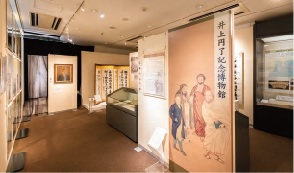

Exhibition highlight 1
“What is unique about the Inoue Enryo Memorial Museum is that Enryo is not introduced as a great person, but instead Enryo is shown in a true-to-life manner, from his childhood until his death." If you focus on the story behind the exhibits, you will surely feel a sense of familiarity with Enryo Inoue. The more carefully you look at the unique Yōkai-hakase collections, and the “traveling philosopher” exhibition, the more Enryo Inoue’s personality will emerge. Immerse yourself in Enryo Inoue’s uniqueness and human magnetism.

Exhibition highlight 2
The explanations will help you to enjoy the exhibits. An example of this is the notebook in the picture. At first glance, this is a “Wahon (old Japanese bookbinding)”. However, on closer inspection, this is Enryo Inoue’s self-made collection of Chinese poetry that recites the impatience and joy typical of one’s youth. The explanation reveals that this is a humorous parody of a famous Chinese poem. His youthful sensitivity is no different from the students of today.
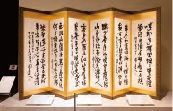
Exhibition highlight 3
There is a story behind every one of the gold folding screens. In fact, this folding screen calligraphy depicts the Chinese poems Enryo wrote with his writing brush during his trip around the world and with one country for each panel. Instead of photography or sketching as we would be common modern times, Enryo made his impressions of Europe, Scandinavia, and America into poems and wrote them as calligraphy. Works similar to these were given to supporters as a thank you for their donations to the Tetsugakukan. You could even say this was the crowdfunding of the Meiji/Taisho period.
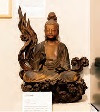
Exhibition highlight 4
A statue of Manjusri, the bodhisattva of wisdom. As a matter of fact, this Buddhist statue was a donation from Kaishu Katsu. Kaishu Katsu recognized Enryo’s passion and character and was one of the strong supporters of the Tetsugakukan. He not only provided both material and psychological support but was also the benefactor who gave Enryo a perspective for management.

Exhibition highlight 5
The “Yōkaigaku-kōgi”, which are a written record of the lectures of mystery studies (Enryo researched since his time as a student) at the Tetsugakukan, are also on display at the Museum. This book which scientifically explained yōkai, was very well received and was also presented to Emperor Meiji. This book is the source of the famous lecture “Yōkai gaku (Mystry Studies)” at the current Toyo University.
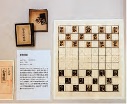
Exhibition highlight 6
Enryo was concerned about how to communicate the seemingly complex discipline of philosophy to the public. That was when Enryo came up with the idea of a game based on go, shogi, and chess. The game was called “Philosophy shogi checkers.” It was said to have been sold with a guide. Such unique ideas were typical of Enryo.
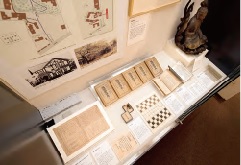
●Learn more about Enryo through books
Toyo University Library
At each campus’s library, there are many books and materials concerning Enryo Inoue available. As a philosopher and as the forefather of yōkai studies, there are a variety of approaches to begin your research of Enryo Inoue. There is also an ample variety of books concerning Enryo Inoue. Try to find a book that matches your curiosity.
Digital books
“The Educational Principles of Enryo Inoue,” “A Booklet on the History of Toyo University,” and “The Life of Enryo Inoue” can be viewed on the Enryo Inoue Philosophy Center’s page on the official Toyo University website.(English unavailable)
https://www.toyo.ac.jp/about/founder/iecp/Publication/
Additionally, you can view all 25 volumes of “Enryo Inoue’s Selected Works,” which features Enryo Inoue’s major works (books and lecture transcripts) rewritten in modern Japanese to make them easier to read for present-day readers.(English unavailable)
https://sites.google.com/toyo.jp/iecp-research/researchpub/Inoue-Enryou-anthology

Enryo Inoue’s Philosophy and Thought
Makio Takemura, Shunjusha
A work by Makio Takemura, the former president of Toyo University, which reveals the thoughts and actions of Enryo Inoue in a unified manner Takemura also considers how Enryo’s educational principles is being passed down to the present-day Toyo University.

Why do Japanese People Fear Yōkai? - Enryo Inoue’s Lecture on Yōkai Studies -
Setsuo Miura, Shin-Jinbutsuoraisha
Enryo Inoue tried to remove ancient superstitions from society, and Kunio Yanagida tried to record and preserve folk traditions. While comparing the yōkai research of the same era, this book shows Japanese people’s mindset towards yōkai.

The History and Future of Enryo Inoue’s Philosophical Mind
Edited by Kodansha Comic Create, Kodansha
This the definitive “Introduction to Enryo Inoue.” The book introduces the achievements and personality of Enryo Inoue, who impacted a wide range of fields, including philosophy, education, and religion, and worked on the spiritual modernization of Japan.
●Gakuso-sai (Founder's Ceremony)
Enryo Inoue’s life came to an end at the age of 61, when he collapsed while giving a lecture in Dalian, China, in 1919. On June 6, 2021, the 103 anniversary of Enryo’s death, we held the Gakuso-sai at the Renge-Ji Temple (Nakano-ku, Tokyo). Around 100 people attend on a regular year. However, to prevent the spread of COVID-19 this year, a small-scale Gakuso-sai was held with only related persons attending.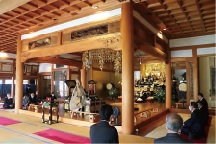
●Tetsugaku-dō-sai (Philosophy Shrine Ceremony)
The Tetsugakudosai is a lecture meeting held every year on the first Saturday of November at the Tetsugakudo Park (The Temple Garden of Philosophy) based on the last will and testament of Enryo Inoue, who hoped for the popularization of philosophy. This lecture meeting is open to the public, and Four Sages celebrated at the Tetsugakudo, Confucius, Buddha, Socrates, and Kant, are covered in order.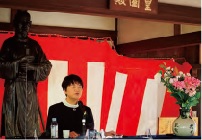
●Investigate further with videos
The Founder of Toyo University: The Travelling Philosopher Enryo Inoue
東洋大学 Toyo univ
A video that retraces the footsteps of Enryo Inoue. This video is a must-watch as a student of Toyo University.

https://www.youtube.com/watch?v=yGnnCgIfzfU
Enryo Inoue and the Tetsugakudo Park: The Advice from Philosophy that Lives on to the Present Day
Nakano Ward Official Channel
An overview from Enryo’s upbringing to the construction of the Tetsugakudo Park—a visual representation of the world of philosophy.
